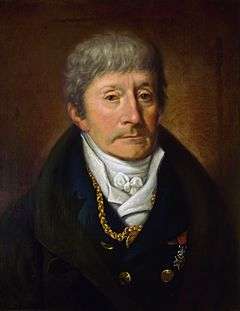Tarare (opera)
| Antonio Salieri |
|---|
 |
|
Operas
|
Tarare is an opéra (tragédie lyrique) composed by Antonio Salieri to a French libretto by Pierre Beaumarchais. It was first performed by the Paris Opera at the Théâtre de la Porte Saint-Martin on 8 June 1787.[1] Salieri also reworked the material into an Italian version retitled Axur, re d'Ormus with libretto by Lorenzo da Ponte, which opened in Vienna in January 1788.
Roles
| Cast | Voice type[2] | Premiere, 8 June 1787[3] (Conductor: Jean-Baptiste Rey ) |
|---|---|---|
| The genius that presides over the reproduction of creatures, or Nature | soprano | Mlle Joinville |
| The genius of fire, which presides over Sun, in love with Nature | basse-taille (bass-baritone) | Louis-Claude-Armand Chardin (stage name, "Chardini") |
| Atar,[4] King of Ormus, a wild and unrestrained man | basse-taille (bass-baritone) | Auguste-Athanase (Augustin) Chéron |
| Tarare,[4] a soldier in his service, honoured for his great virtues | taille (baritenor) | Étienne Lainez |
| Astasie,[4] Tarare's wife, both tender and pious | soprano | Marie Thérèse Maillard |
| Arthénée,[4] High Priest of Brahma, a misbeliever devoured by pride and ambition | basse-taille (bass-baritone) | Martin-Joseph Adrien |
| Altamort,[4] an army general, son of the High Priest, a reckless and fiery youth | basse-taille (bass-baritone) | M Châteaufort |
| Urson, captain of Atar's guard, a valiant man of great honor | basse-taille (bass-baritone) | M Moreau |
| Calpigi,[4] chief of the Eunuchs, an European slave and a former singer emerged from the Chapels of Italy, being sensitive and gay | haute-contre | J. Rousseau |
| Spinette,[4] an European slave woman, Calpigi's wife and a former Neapolitan cantatrice, being meddlesome and coquettish | soprano | Adelaïde Gavaudan, "cadette" |
| Elamir, a boy of the Augurs, being naive and very devout | boy soprano | Joseph-François-Narcisse Carbonel[5] |
| A priest of Brahma | basse-taille (bass-baritone) | M Le Roux "cadet" (the younger)[6] |
| A slave | basse-taille (bass-baritone) | M Le Roux "cadet" (the younger) |
| A eunuch | basse-taille (bass-baritone) | M Le Roux "cadet" (the younger) |
| A shepherdess/A shadow (prologue) | soprano | Anne-Marie-Jeanne Gavaudan "l'aînée" |
| A peasant | basse-taille (bass-baritone) | M Dessaules |
References
- Notes
- ↑ Amadeus Almanac, accessed March 18, 2010.
- ↑ "Tarare di Salieri" at italianOPERA.org, accessed June 10, 2010.
- ↑ According to the original libretto.
- 1 2 3 4 5 6 7 This character also appears in the prologue in the form of his/her own shadow.
- ↑ Carbonel, a singing student of the Paris Opera, was fourteen when he took part in the premiere of Tarare (Alexandre Choron & François Fayolle (editors), Dictionnaire Historique des Musiciens, Paris: Valade/Lenormant, 1810, I, p. 118, accessible for free online at Internet Archives).
- ↑ Le Roux was a member of the Choir included among the tailles (bari-tenors) (cf. composition of the Choirs reported in the original libretto).
- Sources
- Original libretto: Tarare, Opéra en cinq actes, avec un prologue; Représenté, pour la première fois, sur le Théâtre de l'Académie Royale de Musique, le vendredi 8 Juin 1787, Paris: Delormel, 1787 (accessible for free online at books.google)
- Georges d'Heylli & Fernand de Marescot (editors), Théâtre complet de Beaumarchais. Réimpression des éd. princeps, avec les variantes des ms originaux ..., Paris: Académie des bibliophiles, 1869-1871, IV, pp. 1–171 (accessible for free online at Gallica, Bibliothèque Nationale de France)
- Dizionario dell'opera, page: Tarare, "myword.it"
External links
- The score of Tarare is available at the University of North Texas Music Library.
This article is issued from Wikipedia - version of the 10/31/2016. The text is available under the Creative Commons Attribution/Share Alike but additional terms may apply for the media files.